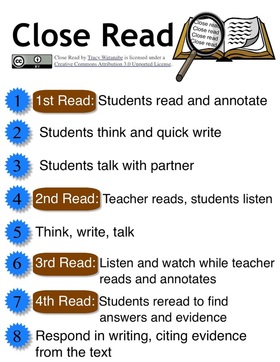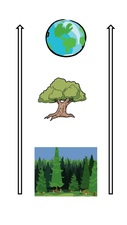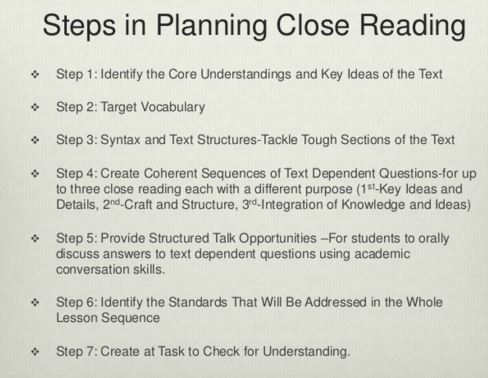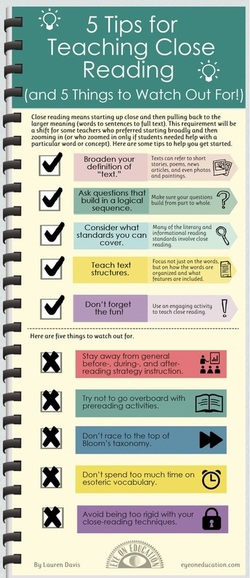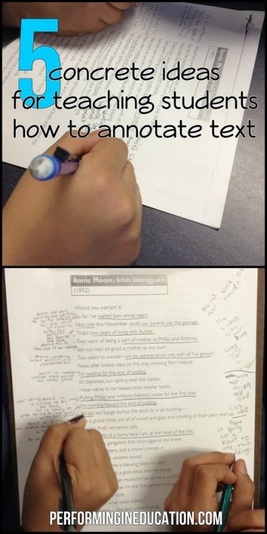
Back 2 Back
Face 2 Face:
What do you want students to look for when they read?
What do you want students to do when they read?
What do your students struggle with when they read?
Face 2 Face:
What do you want students to look for when they read?
What do you want students to do when they read?
What do your students struggle with when they read?
Today's Targets:
Teachers can...
Teachers can...
- Describe the concept of close reading.
- Identify texts that are worthy of close reading.
- Communicate the ultimate goal of the close reading skill.
- Choose text-dependent questions to accompany a close reading text.
|
Close Reading Is...
|
Is Not...
|
A Close Look at Close Reading: Fantastic, concise resource for close reading. Check out pages 10-13 for excellent Common Core-aligned text dependent questions.
Your browser does not support viewing this document. Click here to download the document.
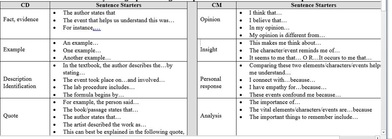
Sentence Starters for citing text evidence
Great strategy to help students incorporate text evidence into sentence and paragraph constructed responses
Great strategy to help students incorporate text evidence into sentence and paragraph constructed responses
Common Core Literacy Reading Standards
Key Ideas and Details:
CCSS.ELA-LITERACY.RST.9-10.1
Cite specific textual evidence to support analysis of science and technical texts, attending to the precise details of explanations or descriptions.
CCSS.ELA-LITERACY.RST.9-10.2
Determine the central ideas or conclusions of a text; trace the text's explanation or depiction of a complex process, phenomenon, or concept; provide an accurate summary of the text.
CCSS.ELA-LITERACY.RST.9-10.3
Follow precisely a complex multistep procedure when carrying out experiments, taking measurements, or performing technical tasks, attending to special cases or exceptions defined in the text.
Craft and Structure:
CCSS.ELA-LITERACY.RST.9-10.4
Determine the meaning of symbols, key terms, and other domain-specific words and phrases as they are used in a specific scientific or technical context relevant to grades 9-10 texts and topics.
CCSS.ELA-LITERACY.RST.9-10.5
Analyze the structure of the relationships among concepts in a text, including relationships among key terms (e.g., force, friction, reaction force, energy).
CCSS.ELA-LITERACY.RST.9-10.6
Analyze the author's purpose in providing an explanation, describing a procedure, or discussing an experiment in a text, defining the question the author seeks to address.
Integration of Knowledge and Ideas:
CCSS.ELA-LITERACY.RST.9-10.7
Translate quantitative or technical information expressed in words in a text into visual form (e.g., a table or chart) and translate information expressed visually or mathematically (e.g., in an equation) into words.
CCSS.ELA-LITERACY.RST.9-10.8
Assess the extent to which the reasoning and evidence in a text support the author's claim or a recommendation for solving a scientific or technical problem.
CCSS.ELA-LITERACY.RST.9-10.9
Compare and contrast findings presented in a text to those from other sources (including their own experiments), noting when the findings support or contradict previous explanations or accounts.
Range of Reading and Level of Text Complexity:
CCSS.ELA-LITERACY.RST.9-10.10
By the end of grade 10, read and comprehend science/technical texts in the grades 9-10 text complexity band independently and proficiently.
Key Ideas and Details:
CCSS.ELA-LITERACY.RST.9-10.1
Cite specific textual evidence to support analysis of science and technical texts, attending to the precise details of explanations or descriptions.
CCSS.ELA-LITERACY.RST.9-10.2
Determine the central ideas or conclusions of a text; trace the text's explanation or depiction of a complex process, phenomenon, or concept; provide an accurate summary of the text.
CCSS.ELA-LITERACY.RST.9-10.3
Follow precisely a complex multistep procedure when carrying out experiments, taking measurements, or performing technical tasks, attending to special cases or exceptions defined in the text.
Craft and Structure:
CCSS.ELA-LITERACY.RST.9-10.4
Determine the meaning of symbols, key terms, and other domain-specific words and phrases as they are used in a specific scientific or technical context relevant to grades 9-10 texts and topics.
CCSS.ELA-LITERACY.RST.9-10.5
Analyze the structure of the relationships among concepts in a text, including relationships among key terms (e.g., force, friction, reaction force, energy).
CCSS.ELA-LITERACY.RST.9-10.6
Analyze the author's purpose in providing an explanation, describing a procedure, or discussing an experiment in a text, defining the question the author seeks to address.
Integration of Knowledge and Ideas:
CCSS.ELA-LITERACY.RST.9-10.7
Translate quantitative or technical information expressed in words in a text into visual form (e.g., a table or chart) and translate information expressed visually or mathematically (e.g., in an equation) into words.
CCSS.ELA-LITERACY.RST.9-10.8
Assess the extent to which the reasoning and evidence in a text support the author's claim or a recommendation for solving a scientific or technical problem.
CCSS.ELA-LITERACY.RST.9-10.9
Compare and contrast findings presented in a text to those from other sources (including their own experiments), noting when the findings support or contradict previous explanations or accounts.
Range of Reading and Level of Text Complexity:
CCSS.ELA-LITERACY.RST.9-10.10
By the end of grade 10, read and comprehend science/technical texts in the grades 9-10 text complexity band independently and proficiently.
